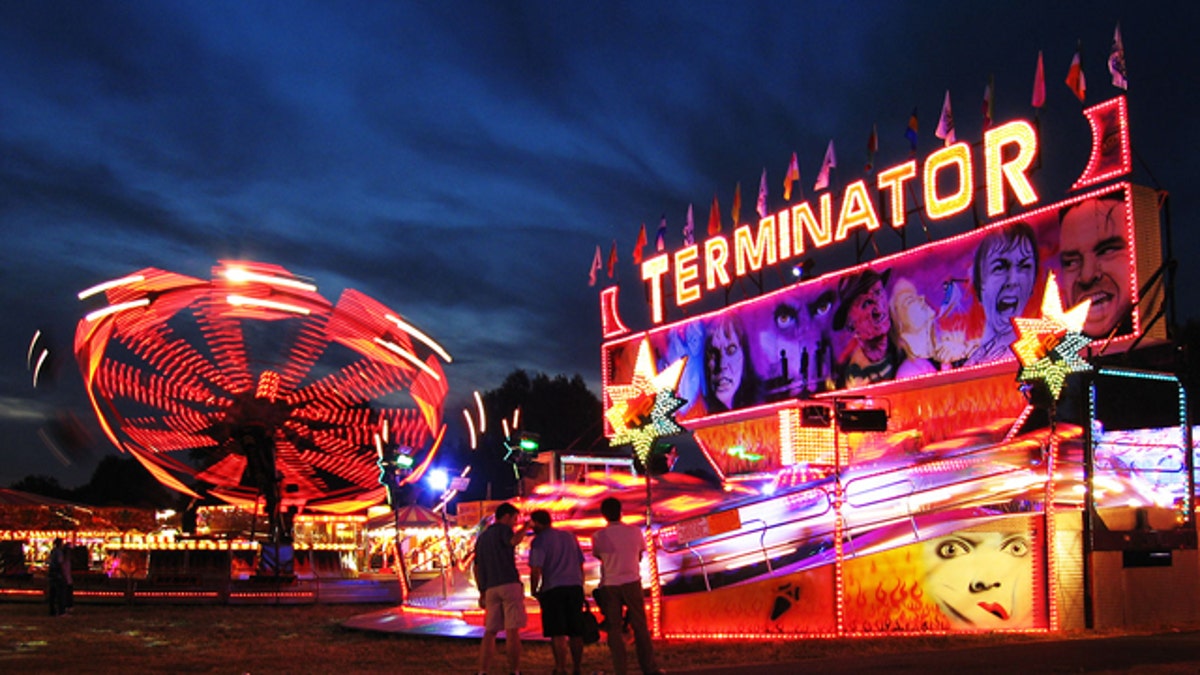
Rides glow at night at the Cambridge Midsummer Fair amusement park. (Wikipedia / Andrew Dunn)
MONROE, Wash. – Thousands of people will head to State Fairs this summer to step aboard rides that thrill, terrify and delight -- each drop, every whirl, every stomach-flipping loop grounded in basic laws of physics.
Take the Zillerator, the only full-size rollercoaster at the Evergreen fairgrounds in Washington. It offers a lesson in gravity and other physical forces, and when people plummet on the Super Shot Drop Tower, they are experiencing the power of magnetism, The Daily Herald explains in Sunday's newspaper.
Even something as simple as bumper cars illustrate laws of Newtonian physics.
That's why Clarence Bakken of Sunnyvale, Calif., has taken his high school physics class to amusement parks over and over during his 35 years as a teacher.
"So many things that happen at an amusement park involve rules that we study in a physics class," said Bakken, who has written a book about amusement park physics. "On a ride, you can experience them in a powerful but safe way."
Your body also experiences physical reactions, in subtle and not-so-subtle ways, triggered by the speeds, turns and terror of amusement rides.
"The rides make all of us fighter pilots," said James Lee, a doctor of internal medicine at The Everett Clinic. "The gravity force is no different than during high-speed flying."
Here's a look at a handful of rides, the science behind them and what happens to you when you ride them.
Like all typical rollercoasters, the Zillerator has no engine. It's lifted up the first hill by a chain mechanism and propelled downward by the forces of nature.
Gravity and momentum take it all the way to the end, Bakken said. To understand how this happens, imagine riding a bicycle. You begin by pedaling, but after it reaches a certain speed it will move by itself.
The ride gains what is called potential energy on the way up and uses kinetic energy on the way down, Bakken said. Potential energy comes from gravity. Kinetic energy is the energy of motion.
The most exciting part of roller-coaster rides is the dip at the bottom of the first -- and tallest -- hill. At that point, you weigh several times what you normally do, Bakken said.
You don't crash through the rails at the bottom and slam into the Earth because the tracks won't let you. In physics terms, another force is at play -- the normal force. That's the force from the ground, or in this case, the tracks, pushing back at you and making you change direction.
The Nitro sways back and forth like a giant pendulum, swinging as many as 24 people high into the air. As your body reaches that weightless moment at the high point of each swing, your seat spins and your feet dangle in the air.
You experience free fall at the high point of each swing, said Andrew Laszlo, a doctoral student at the University of Washington physics department.
"If you were standing on a scale at this point in the ride, for a moment, it would read zero," he said. It's similar to what astronauts experience in space.
Weightlessness isn't the absence of gravity; it's the absence of that normal force -- the force of the ground, your seat or your rollercoaster harness pushing back at you, Laszlo said.
The Super Shot Drop Tower looms over the fairgrounds. Passengers are strapped into seats all around the base of the tower. Their feet dangle as they slowly ascend. After a few anxious moments, 90 feet in the air, they plunge back to Earth.
A magnetic brake system stops the lift before it reaches the ground. To understand how it works, think about this experiment you may have conducted in a physics class: Put a piece of copper on the table. Then take a magnet and start moving it back and forth above the copper. A magnetic field will be created, and you will feel the metal resisting.
Copper is one of the metals affected in this way because electrons in the metal move easily and freely. That's why it's used for electrical wires.
In the Super Shot Drop Tower, the magnetic field created by this interaction will stop the lift from reaching the ground, Bakken said.
This brake system uses no electricity, so if the power goes out while you are in the Super Shot Drop Tower, you will still stop. Magnetic brakes are preferred over regular brakes because they are virtually foolproof, produce no noise or smell and never touch the ride. The magnet is hidden behind the passenger seating area, and the copper is in special fins located along the tower, Bakken said.
